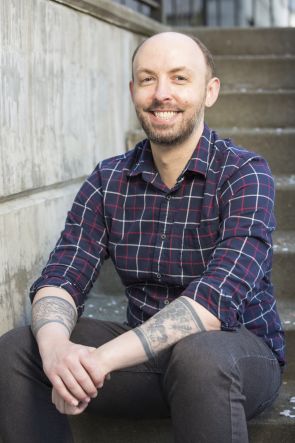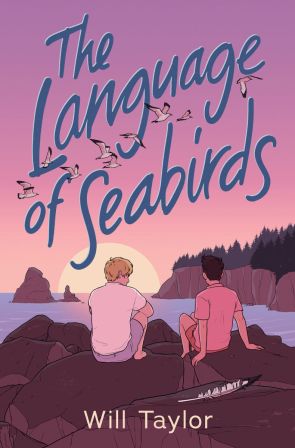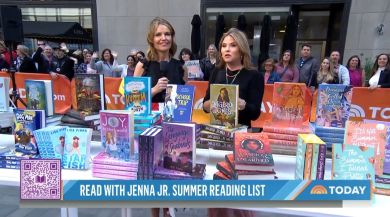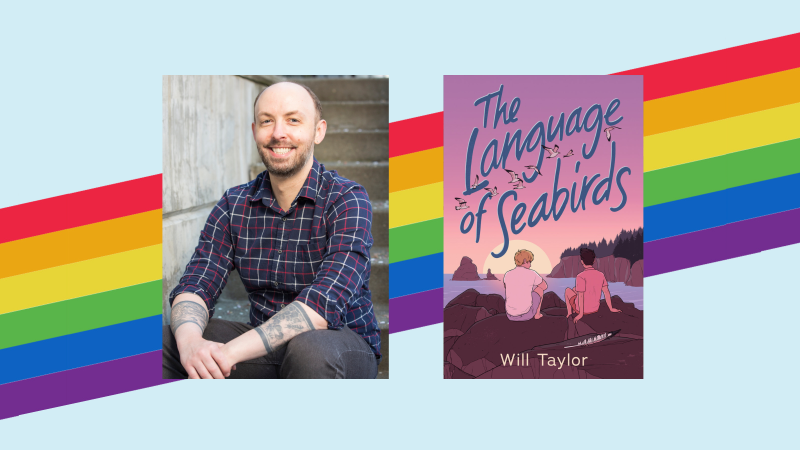 Will Taylor’s The Language of Seabirds is a deeply moving story about first love – and the coexisting joys and challenges of growing up. In celebration of Pride Month, we caught up with Will about what inspires him, why this story is personal, and what he hopes readers will find its pages.
Will Taylor’s The Language of Seabirds is a deeply moving story about first love – and the coexisting joys and challenges of growing up. In celebration of Pride Month, we caught up with Will about what inspires him, why this story is personal, and what he hopes readers will find its pages.
What inspired The Language of Seabirds?
It sounds like such a fairytale, but it all came from one image that dropped into my mind on a rainy February evening. I was watching a Netflix show about the Danish restaurant NOMA, and the chef was talking about how they’d built an “alphabet of local ingredients” they used to write the “language and poetry” of their food. Someone was gathering moss and mushrooms on the screen, but out of nowhere my mind filled with an image of a boy running along a beach in high summer and another boy—shy, careful—watching him from the porch of a nearby house. The words “the language of seabirds” drifted down over the scene,and that was it, I was hooked.
Funnily (interestingly? coolly?) enough, I was just reading some of Ursula K. Le Guin’s essays the other day, and she mentioned how for her books always began with an image of a person, usually in a landscape and at a distance. “The place is there, the person is there. I didn’t invent him, I didn’t make her up: he or she is there. And my business is to get there, too.” She goes on to describe how her great novel The Left Hand of Darkness began with an image like that, and how “all the rest of it, with its strange arrangements of human gender and its imagery of betrayal, loneliness, and cold, is my effort to catch up, to get nearer, to get there, to where I had seen those two figures on the snow, isolated and together.”
Ursula K. Le Guin is my favorite author of all time, and it feels downright providential that thanks to Seabirds I know exactly what she means.
(The essay quoted above is called Science Fiction and Mrs. Brown, by the way, and appears in the newly released The Language of the Night collection from Scribner. I cannot recommend it enough.)
The book explores a lot of change in Jeremy’s life, from his parents’ divorce and his temporary move to his unexpected feelings for Evan and his evolving relationship with his dad. How did you balance writing about the joy of finding love and the challenges of going through some really difficult change?

That all came easily, to be honest, as my own parents divorced when I was thirteen following several hard years. I had my queer awakening during those years, but the crumbling family dynamics made the idea of sharing it beyond impossible. (Not that it was that likely anyway; it was the early 90s, and I had zero queer rep to lean on apart from comedic caricatures and AIDS-focused media panic.) When I began writing Jeremy and discovered he was in the same situation, I never even questioned it. All kids are experiencing big change around the age of twelve, but this was a specific scenario I knew I could write with full emotional honesty.
I also used that see-saw balance of positive change/difficult change on purpose as a deliberate writing trick. It’s a technique I loved sharing with my ninth graders when I did guest-teacher classroom work. I used to draw out the plot points of Romeo & Juliet and the Black Panther movie together on the board, showing how every time something improves for the protagonists, something from the B Plot gets proportionally worse. This continues until both patterns escalate to a crisis point. In Seabirds, Jeremy and Evan’s growing friendship is punctuated by Jeremy’s troubles with his dad, and in the second half Jeremy’s desire to spend as much time with Evan as possible before he leaves is actually what drives the looming parental showdown. It was deeply satisfying getting to use the technique in my own work so directly.
You captured the feelings of adolescence and first love so vividly and with so much vulnerability. How did you get back into that frame of mind as you were writing?
Oh goodness, thank you! The short answer: music. I was a wildly romantic kid, even though I’d deadbolted myself into the closet, and I used to fall asleep listening to the “Lights Out” program on Seattle’s soft-rock station, one of those shows where people call in and dedicate songs to their loved ones. I made a Spotify playlist early in the writing process and returned to it over and over, melting back into that pure yearning fifth grade-me felt listening to Foolish Beat byDebbie Gibson, Right Here Waiting by Richard Marx, or Hands to Heaven by Breathe. There were songs from my high school days, too: The Goo Goo Dolls’ Slide, Natalie Imbruglia’s Torn, the Counting Crows’ cover of The Ghost in You from the Clueless soundtrack, I’m Kissing You by Des’ree. More recent tracks also found their way into Jeremy’s story, like Mystery of Love by Sufjan Stevens, Bloom by The Paper Kites, and Kids in the Dark by Bat for Lashes. Peter Broderick’s And It’s Alright was a lucky late discovery, an eerily perfect song for the cliff scene that forms the central point of the book.
Jeremy’s relationship with Evan is juxtaposed with his relationships with each of his parents, neither of whom seem to see him as fully as Evan does. What did you want to explore about how Jeremy interacts with the people in his life?
Jeremy’s two weeks on the beach are governed by a desire to spend as much time as possible with his cute new friend Evan and as little time as possible with his dad. When he doesn’t feel safe saying why, his dad takes it personally and reacts badly. The irony is that if Jeremy had met a girl, his dad would have been delighted. It’s the fact that Jeremy can’t tell his dad the truth behind his actions that feeds their growing crisis, and that same withholding comes up in the awkward phone calls with his mom. Jeremy has learned that most grownups are too busy focusing on themselves to be trusted with his deepest secret, and here in this in-between time on the Oregon coast he levels up his hiding and avoiding skills rapidly. Of course, this gets harder as time goes on, which was stressful to write but meant the sweet scenes where Evan sees Jeremy—really sees him—could land with much more power. Jeremy’s baffled joy and growing willingness to be seen is I think my favorite element of the book.
Can you talk more about the secret language of seabirds and why it was important for Evan and Jeremy to have their own code?
There’s the surface-level symbolism of queer safety in an unsafe world, of course. The queer language of flowers is an important and well-established example, and there have been many other systems used by queer people throughout history to find and communicate with each other. Equally important for this book, though, is the element of childhood and play. Jeremy and Evan are twelve, an age when kids may start to feel immense social pressure to stop playing pretend, stop imagining, stop being “weird.” (Speaking from experience here.) I wanted to show Jeremy and Evan finding in each other the permission and opportunity to keep being kids, even as all the new fears and questions and adventures of adolescence are appearing on the horizon, and the fun of making up a secret code was a big part of that.
A third element is the shared reality the bird code creates. By constructing and using it, Jeremy and Evan carve their own space in the world around them, their own fold in time. It’s something completely in their power, something only they get to make and control, and that is a big thing when you’re young.There’s a moment near the end when Jeremy shares a single word of the seabird language with his father—a major synthesis of his two Oregon coast worlds—and that one act shows just how much he’s changed over the course of the story. He’s gained the confidence to be generous.
Birds are such a big part of this book! Do you have a special connection to them?
I don’t know if I’d claim a special connection—I just love them, seabirds and shorebirds in particular. The conversation Jeremy and Evan share about what kinds of birds they’d want to be is a direct look inside my own head. I would love to be a seagull and be able to soar over the tallest buildings and sit down on the ocean with equal comfort.
The birds also play a huge symbolic role in the story (so much symbolism talk today!). I got my BA in sacred architecture, and one of the foundational aspects of many sacred buildings is the deliberate use of the vertical axis. “Mountains and caves” is how one scholar put it. I’ve been drawn equally to sacred buildings and kidlit my whole life, and I realized several years back that both share that fascination with the vertical. As adults, we live in a world that is largely arranged for us, almost entirely in the horizontal plane. For kids, though, the world is much more vertical, and increased access to the vertical for them means greater experience and, usually, power. I’ll stop there, because I could honestly talk about this all day, but I leaned heavily on the birds in this book to give that sense of height and possibility and huge, quiet wonder that only the vertical axis can provide.

The Language of Seabirds was on Jenna Bush Hager's Read with Jenna Jr. 2023 summer reading list.
You said in your author’s note that you hid from your feelings when you first fell in love, and that you wanted to write a story that celebrates big feelings instead of pushing them away. I think a lot of people can relate to that. What do you want readers to take away from this story?
Above all, a road map. A storehouse of rich, clear images of queer young love they can carry with them. That was what I needed when I was twelve, and it simply wasn’t available. Not anywhere. Without it, I had no idea what two boys falling in love could look like. I couldn’t visualize it, let alone imagine it being something that might happen to me. I didn’t come out until after college—which was also when I read my very first book with a queer protagonist—and had to learn how to navigate romance as a beginner in my mid-twenties. I had no foundation, no map, no storehouse. I wrote The Language of Seabirds for my younger self, retroactively, and for everyone of any age who needs to see someone like them facing the world with their whole heart and coming through happy.
Is there anything else you’d like to share?
More books! Always more books! Anyone who enjoyed Seabirds or just loves a good MG summer romance absolutely needs to read In the Key of Us by Mariama J. Lockington, The Mighty Heart of Sunny St. James by Ashley Herring Blake, and Lunar Boy by Jes and Cin Wibowo.
You can Read with Pride all year long: check out more books that amplify LGBTQIA+ voices and experiences.



